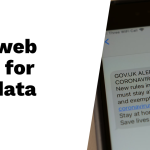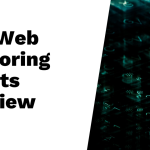In 2025, dark web reports play a key role in protecting personal data by offering early warnings about leaked information. These reports come from continuous monitoring of hidden internet areas where stolen data is shared. By receiving real-time alerts, individuals and organizations can act quickly to stop identity theft or financial fraud before it worsens. The use of AI helps spot threats faster and more accurately, making the whole process more reliable. While free scanners miss a lot, enterprise tools provide broader coverage and detailed risk assessments. Overall, these reports support compliance with privacy laws and help maintain trust by reducing the impact of cyberattacks.
Table of Contents
- Dark Web Monitoring and Its Role in Cybersecurity in 2025
- How Dark Web Reports Detect Compromised Personal Data
- Features That Make Dark Web Reports Effective
- Step-by-Step Process of Dark Web Monitoring
- Artificial Intelligence Powering Dark Web Threat Detection
- Personal Data Protection Benefits from Dark Web Reports
- Types of Data and Threats Found on the Dark Web
- Why Free Dark Web Scanners Fall Short
- Ensuring Privacy Compliance Through Dark Web Monitoring
- Emerging Challenges and Future Trends in Dark Web Surveillance
- Best Practices for Using Dark Web Reports in 2025
- How Continuous Dark Web Monitoring Prevents Data Breaches
- Frequently Asked Questions
13.1. What exactly are dark web reports and how do they find my personal data?
13.2. How can using dark web reports help me prevent identity theft in 2025?
13.3. Are dark web reports reliable for catching new data breaches before they cause problems?
13.4. What types of personal data show up most often in dark web reports?
13.5. How should I respond if my data appears in a dark web report?
Dark Web Monitoring and Its Role in Cybersecurity in 2025

The dark web remains a hidden part of the internet where stolen data, hacking tools, and illegal services are traded in secrecy. In 2025, dark web monitoring plays a critical role in cybersecurity by continuously scanning these concealed markets, forums, and encrypted chat rooms to detect leaked personal information, passwords, financial details, and business secrets. Cybercriminals are becoming more advanced and frequent in their attacks, which makes ongoing surveillance essential for both individuals and organizations. This monitoring process uses specialized tools and expertise to access encrypted and private dark web sources that are otherwise difficult to reach. It not only helps identify exposed data early, often before harm occurs, but also gathers intelligence on attacker behavior and new threat tactics. Since dark web content changes rapidly, real-time, constant scanning is necessary to reduce the risk of stolen data going unnoticed for months. Without such vigilance, breaches can lead to identity theft, financial loss, and operational disruptions. By integrating dark web monitoring into cybersecurity strategies, people and businesses can better protect their assets and respond swiftly to emerging cyber threats.
How Dark Web Reports Detect Compromised Personal Data
Dark web reports detect compromised personal data by compiling results from extensive scans across hidden marketplaces, hacker forums, and encrypted channels where stolen information is traded or shared. These reports match scanned data against user-specific details like email addresses, passwords, credit card numbers, or identity documents to pinpoint any exposures. They provide clear information on the type of data found and the exact locations where it appeared, such as dark web markets or underground forums, giving vital context for understanding the threat. Timestamps included in the reports indicate when the data was first observed, helping users track if the exposure is recent or ongoing. By assessing the risk level of each detected item, the reports guide urgency and next steps, often suggesting immediate actions like password changes or account freezes. Some advanced dark web reports are integrated with security systems to trigger automatic alerts and responses, reducing the time between compromise and remediation. Additionally, continuous monitoring allows these reports to track repeated leaks of the same data, alerting users to persistent threats that require more robust intervention. Overall, dark web reports serve as early warning tools, helping individuals and organizations detect and respond to data breaches before significant damage occurs.
Features That Make Dark Web Reports Effective
Dark web reports have become essential tools for protecting personal data in 2025 due to their advanced features tailored for today’s complex cyber threats. One key feature is real-time alerts, which notify users instantly when their information appears on the dark web, enabling swift action to prevent damage. These reports rely on comprehensive scanning that covers a wide range of dark web sources, including encrypted and private channels often missed by simpler tools. AI-driven detection plays a crucial role by analyzing subtle patterns and emerging threats that traditional methods might overlook, improving detection accuracy significantly. Customizable monitoring allows organizations to focus on their most valuable assets, like employee emails or intellectual property, making the reports more relevant and manageable. Rather than overwhelming users with raw data, dark web reports provide detailed risk assessments that explain the potential impact and offer clear remediation steps, helping prioritize responses effectively. Continuous 24/7 surveillance ensures monitoring gaps are minimized, reducing the window for attackers to exploit stolen data. Integration capabilities with existing cybersecurity tools streamline incident response, making dark web intelligence a seamless part of an organization’s defense strategy. Additionally, user-friendly dashboards present complex threat information in an accessible way, helping even non-experts understand risks and take appropriate actions. Finally, regular updates keep the monitoring systems aligned with the ever-evolving dark web environment and attacker tactics, maintaining the reports’ effectiveness over time.
Step-by-Step Process of Dark Web Monitoring
Dark web monitoring begins with automated crawlers scanning a wide range of dark web sites, forums, marketplaces, encrypted chat rooms, and private groups. These crawlers gather sensitive information like stolen credentials, financial data, and corporate secrets often traded or shared by cybercriminals. Once collected, this data is matched against databases containing personal or corporate assets to identify exact compromises. At the same time, threat intelligence is developed by analyzing attacker methods and emerging trends, helping predict new risks. When a match is detected, real-time notifications alert affected individuals or organizations immediately, allowing for quick response to limit damage. Detailed reports follow, outlining the type of exposure, risk severity, and recommended steps to mitigate the threat. This monitoring cycle repeats continuously, 24/7, ensuring new leaks are caught promptly. Machine learning plays a critical role by refining detection accuracy over time, learning from false positives and adapting to evolving dark web activities. Security teams rely on these insights to react swiftly, containing breaches, resetting compromised credentials, and preventing further data loss. This proactive process significantly shortens the time stolen data remains undetected, from months in the past to just days or even hours today, giving users a better chance to protect their personal information.
Artificial Intelligence Powering Dark Web Threat Detection

Artificial intelligence plays a crucial role in enhancing dark web threat detection in 2025 by rapidly scanning vast amounts of data from hidden marketplaces, forums, and encrypted channels. AI models spot suspicious patterns that might go unnoticed by human analysts, while machine learning continuously adapts to new hacker tactics by training on fresh data streams. This ongoing learning process helps improve detection accuracy, reducing false alarms and ensuring real threats are flagged promptly. AI also enables predictive analysis, allowing security teams to identify risks before stolen data is widely exploited. By automatically classifying data types and prioritizing alerts based on severity, AI ensures that critical issues get immediate attention. Custom algorithms tailor the scanning process to specific industries or data types, increasing relevance and efficiency. Natural language processing techniques help interpret complex forum discussions and hidden messages, unveiling subtle clues about emerging threats. Moreover, AI supports automation of alerts and remediation workflows, providing 24/7 monitoring without human fatigue or oversight gaps. This continuous surveillance shortens the time between data compromise and detection, strengthening overall cybersecurity defenses and helping organizations respond faster to dark web exposures.
Personal Data Protection Benefits from Dark Web Reports
Dark web reports offer significant advantages for protecting personal data by detecting leaked information early, which limits the chances of misuse like identity theft or financial fraud. When sensitive details such as passwords, social security numbers, or banking data appear on the dark web, these reports provide timely alerts that enable quick response actions like password resets and account monitoring. This fast reaction helps prevent further damage and reduces the risk of prolonged cyberattacks that disrupt operations. Additionally, organizations benefit from maintaining customer trust through proactive security measures, showing stakeholders that their data safety is a top priority. Dark web monitoring also supports compliance with regulations like GDPR, HIPAA, and PCI DSS by demonstrating breach awareness and timely intervention, which helps avoid costly fines and legal penalties. Beyond immediate protection, these reports supply valuable evidence for incident response and forensic investigations, helping organizations understand the breach scope and improve defenses. They also guide security investment decisions by highlighting actual exposure areas rather than hypothetical risks. Over time, continuous use of dark web reports fosters a stronger security culture and resilience, ensuring that both individuals and businesses are better prepared against evolving cyber threats.
Types of Data and Threats Found on the Dark Web
The dark web hosts a wide range of stolen data and cybercrime tools that pose serious risks to individuals and businesses alike. Usernames and passwords are among the most commonly traded items, often sold in bulk after breaches, enabling attackers to hijack accounts. Financial information, including credit card numbers and banking credentials, frequently appears for sale, fueling fraud and unauthorized transactions. Corporate data like trade secrets and intellectual property also leak onto these hidden markets, threatening business competitiveness and innovation. Beyond data, cybercriminals share phishing kits and ransomware tools, which streamline attacks and increase their reach. Identity documents such as passports and driver’s licenses are exposed, facilitating identity theft and synthetic identity fraud, where fake documents and fabricated personal details are used to create new fraudulent identities. Access credentials to cloud services and corporate networks circulate, opening doors to large-scale data breaches and ransomware infections. Personal health information is another sensitive category found on the dark web, exposing individuals to privacy violations and potential blackmail. Malware strains and exploit codes are traded as well, providing the means for future attacks. All this stolen and shared data supports a wide array of criminal activities, including scams, espionage, financial fraud, and ongoing cyberattacks, making dark web monitoring critical to detect and respond to these threats before they cause damage.
| Type of Data/Threat | Description |
|---|---|
| Usernames and Passwords | Frequently traded after breaches and used for unauthorized access. |
| Credit Card Numbers and Banking Credentials | Appearing for sale or fraud use. |
| Corporate Data | Trade secrets and intellectual property leaked or sold. |
| Phishing Kits and Ransomware Tools | Shared for cybercrime operations. |
| Identity Documents | Passports and driver’s licenses exposed for fraud. |
| Access Credentials | To cloud services or corporate networks traded among attackers. |
| Fake Documents and Synthetic Identities | Available for fraudulent activities. |
| Personal Health Information | Found risking privacy violations. |
| Malware Strains and Exploit Codes | Circulating among threat actors for attacks. |
| Stolen Data Uses | Supporting scams, fraud, espionage, and further cyberattacks. |
Why Free Dark Web Scanners Fall Short

Free dark web scanners might seem like a quick solution, but they come with significant limitations that make them inadequate for serious personal data protection in 2025. These tools usually cover only a handful of public dark web sources, missing many private or encrypted areas where much of the most sensitive stolen data is traded. Their detection accuracy is often poor, producing false negatives that miss real threats or false positives that create unnecessary alarm. Unlike professional services, free scanners rarely offer real-time alerts or continuous monitoring, meaning you might only find out about a breach long after damage is done. They also lack detailed risk assessments and guidance on how to fix exposed issues, leaving users uncertain about the severity or next steps. For organizations, free tools are especially insufficient since they cannot handle large or complex data sets and do not integrate with enterprise security systems, limiting their usefulness. Privacy concerns also arise because these free services may have questionable data handling practices. Additionally, they do not leverage advanced AI or machine learning, technologies critical for detecting sophisticated threats quickly and accurately. Updates to free scanners are infrequent, so they struggle to keep pace with evolving cybercriminal methods. While free dark web scanners can serve as a basic check, relying on them alone is risky. For meaningful personal data protection in 2025, investing in robust, professional dark web monitoring services is essential.
Ensuring Privacy Compliance Through Dark Web Monitoring
Dark web monitoring plays a crucial role in helping organizations meet privacy compliance requirements in 2025. Regulations like GDPR and CCPA require timely detection of data breaches and swift notification to affected users, dark web reports provide the intelligence needed to fulfill these mandates effectively. By identifying compromised data early, organizations can take preventive actions such as enforcing password resets or isolating leaked information, which reduces exposure and helps avoid costly regulatory penalties. These reports also serve as tangible evidence of due diligence, documenting the efforts taken to protect personal data and demonstrating accountability during audits and risk assessments. Furthermore, monitoring supports data minimization principles by pinpointing exposed data that should be removed or restricted, which is essential for maintaining data subject rights and controlling unauthorized use. In sectors like healthcare, dark web monitoring assists in complying with HIPAA standards by safeguarding sensitive patient information. Overall, integrating dark web surveillance into a privacy risk management strategy provides organizations with concrete threat intelligence, which regulators view as a sign of proactive data security management and commitment to upholding privacy laws.
Emerging Challenges and Future Trends in Dark Web Surveillance

As cybercriminals shift towards encrypted messaging apps and decentralized platforms, dark web surveillance faces new hurdles in tracking illicit activities hidden behind advanced privacy layers. Monitoring tools must adapt to these evolving channels, expanding beyond traditional dark web marketplaces and forums to include encrypted chats and peer-to-peer networks. Integrating Cyber Risk Quantification (CRQ) is becoming essential, helping organizations assign clear financial impacts to detected threats and prioritize responses effectively. Proactive takedown services are also gaining traction, aiming to remove stolen data listings before they can be exploited further. Artificial intelligence and machine learning models continuously evolve to detect fresh attack patterns and evasion tactics, but the rapid pace of cybercriminal innovation demands ongoing refinement. Collaboration between organizations and law enforcement agencies improves threat intelligence sharing, enabling quicker identification and disruption of criminal networks. At the same time, ethical and privacy concerns grow as surveillance becomes more pervasive, requiring careful balance to protect individual rights while enhancing security. Employee education remains a critical complement to technical monitoring, as human awareness helps prevent social engineering and insider threats. Looking ahead, future tools may merge dark web intelligence with surface and deep web data to provide a more comprehensive view of emerging risks. Continuous innovation will be necessary to keep pace with the dynamic threat landscape, ensuring dark web reports remain a vital resource for protecting personal data in 2025 and beyond.
Best Practices for Using Dark Web Reports in 2025
To make the most of dark web reports in 2025, start by choosing AI-powered monitoring services that offer real-time alerts and broad coverage, including encrypted platforms where many cybercriminals operate. Tailor your monitoring to focus on critical assets like employee credentials, intellectual property, and customer data to detect risks that matter most to your organization. Integrate these reports directly into your incident response workflows so your team can act quickly to contain threats as soon as they are detected. Use detailed risk assessments from the reports to prioritize threats based on their potential impact and likelihood, ensuring your resources target the highest risks effectively. Continuous 24/7 surveillance is essential to minimize the window of exposure for compromised data, as periodic scans can leave you vulnerable to prolonged breaches. Complement dark web monitoring with strong internal controls such as multi-factor authentication and regular password updates to strengthen your defense layers. Confirm that your monitoring service supports relevant compliance standards like GDPR, HIPAA, or PCI DSS to help meet industry regulations. Leverage insights from dark web intelligence to enhance employee awareness by tailoring cybersecurity training around the latest threat patterns. Regularly review and update your monitoring parameters to keep pace with evolving cybercriminal tactics and newly emerging dark web sources. Finally, partner with providers that offer proactive takedown assistance to help remove stolen data or malicious content from dark web sites, reducing the risk of further exploitation.
- Choose AI-powered monitoring services that provide real-time alerts and comprehensive dark web coverage including encrypted platforms.
- Customize monitoring to focus on key assets such as employee credentials, intellectual property, and customer data for targeted risk detection.
- Integrate dark web reports directly into incident response workflows to enable swift remediation actions upon detection.
- Use detailed risk assessment reports to prioritize threats based on impact and likelihood, allocating resources accordingly.
- Maintain continuous 24/7 surveillance rather than periodic scans to reduce exposure time for compromised data.
- Combine dark web intelligence with internal security controls such as multi-factor authentication and regular password updates.
- Ensure the monitoring service supports compliance requirements relevant to your industry, like GDPR, HIPAA, or PCI DSS.
- Leverage dark web insights to raise employee awareness and tailor cybersecurity training based on emerging threat patterns.
- Regularly review and update monitoring parameters to keep pace with evolving cybercriminal tactics and new dark web sources.
- Partner with services that offer proactive takedown assistance to remove stolen data or malicious content from the dark web.
How Continuous Dark Web Monitoring Prevents Data Breaches
Continuous dark web monitoring relies on automated crawling of dark web markets, forums, and encrypted chat rooms to spot stolen personal and corporate data quickly. By matching this discovered data against internal asset databases, organizations can identify compromised credentials or sensitive information without delay. Real-time alerts allow immediate actions such as password resets, account lockdowns, or notifying legal teams to limit the potential damage. This ongoing surveillance significantly reduces the window of exposure, preventing cybercriminals from exploiting leaked data over extended periods. Advanced AI and machine learning continuously adapt detection models to evolving dark web tactics, increasing the accuracy of threat recognition. Regular dark web reports also shed light on emerging cybercrime trends and tools, enabling proactive defense measures. Beyond minimizing financial losses linked to breach recovery and fines, continuous monitoring supports regulatory compliance by documenting breach detection efforts and enabling prompt notifications to affected parties. When combined with employee training and strong access controls, this creates a layered defense that helps prevent breaches and maintain operational continuity, avoiding disruptions from ransomware or data theft. For example, an early alert about leaked employee credentials can trigger immediate password changes, stopping attackers from gaining access before damage occurs.
Frequently Asked Questions
1. What exactly are dark web reports and how do they find my personal data?
Dark web reports are summaries that show if your personal information, like emails or passwords, has been found on hidden parts of the internet known as the dark web. These reports come from tools that scan dark web marketplaces and forums where stolen data is often traded or shared.
2. How can using dark web reports help me prevent identity theft in 2025?
By regularly checking dark web reports, you can quickly learn if your data has been compromised. If you act fast, like changing passwords or monitoring your accounts, you reduce the chances of someone using your info for identity theft.
3. Are dark web reports reliable for catching new data breaches before they cause problems?
Dark web reports give a good chance to spot stolen data early, but they aren’t perfect. They depend on how well the scanning tools work and what parts of the dark web they cover. Still, they add an important layer of awareness to your overall security checks.
4. What types of personal data show up most often in dark web reports?
Common types include email addresses, passwords, credit card numbers, social security numbers, and sometimes phone numbers or home addresses. These are valuable to cybercriminals for fraud or account takeovers.
5. How should I respond if my data appears in a dark web report?
If you see your data exposed, start by changing your passwords on affected accounts and enable two-factor authentication if available. Review your financial statements for suspicious activity and consider using credit monitoring services for extra protection.
TL;DR Dark web reports in 2025 are crucial for protecting personal data by monitoring hidden cybercriminal activities where stolen info is traded. These reports offer real-time alerts and detailed risk analysis, powered by AI, to detect breaches early and enable fast response. They help prevent identity theft, financial fraud, and support regulatory compliance. Unlike free scanners, advanced dark web monitoring covers a broad range of sources and delivers accurate insights. Continuous surveillance combined with strong security policies and employee training enhances data protection and operational continuity against evolving cyber threats.





